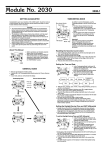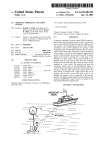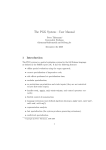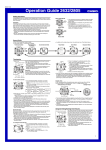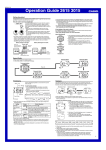Download Casio 2080 Watch User Manual
Transcript
Module No.2080 2080-1 GENERAL GUIDE • If the digital display of your watch is continually changing, see “About Auto Display” for information on how to stop it. • Press C to change from mode to mode. After you perform an operation in Countdown Alarm Mode or Stopwatch Mode, pressing C returns to the Timekeeping Mode. • In the Timekeeping Mode, press D to illuminate the display for about two seconds. Moon Data Mode Timekeeping Mode Sunrise/Sunset Mode TIMEKEEPING MODE The settings you make in the Timekeeping Mode are very important, because they affect the Moon Data, Tide Graph, and Sunrise/Sunset functions. There are three setting screens in the Timekeeping Mode: the Time and Date Setting Screen, DST, GMT Differential, Point Name Setting Screen, and Longitude/Latitude, Lunar Tide Interval Setting Screen. • For normal timekeeping, you need to set the time, and date, and turn daylight saving time (summer time) on or off. • To use the Moon Data, Tide Graph, and Sunrise/Sunset functions, you must set the GMT differential, your current longitude and latitude, and the lunar tide interval on your point. • If you do not operate any button for a few minutes while a selection is flashing, the flashing stops and the watch goes back to the Timekeeping Mode automatically. Countdown Alarm Mode Alarm Mode Stopwatch Mode 2. When the character you want is displayed, press C to advance to the next character. 3. Repeat steps 1 and 2 for all eight characters of the point name. • After you are finished making the settings you want, press A to advance to the Longitude/Latitude, Lunar Tide Interval Setting Screen. Longitude/Latitude, Lunar Tide Interval Setting Screen Longitude Latitude Use this screen to specify the longitude, latitude, and lunar tide interval of your current location. Lunar tide interval Longitude/Latitude Hour Minutes To set the time and date Month - Day • Use this screen to set the current time and date, to Moon graph Tide graph Day of week Hour Minutes Seconds PM indicator reset the seconds to 00, and to toggle between 12-hour and 24-hour timekeeping. 1. In the Timekeeping Mode, check if the DST indicator is displayed, and change the DST setting in accordance with the timekeeping in your area. • Turn on DST if daylight saving time (summer time) is currently in effect in your area. If daylight saving time is not currently in effect in your area, be sure to turn DST off. • See “To turn DST on and off” for details about turning DST on and off. 2. In the Timekeeping Mode, hold down A until the seconds digits start to flash. This is the Time and Date Setting Screen. 3. Press C to move the selection around the display in the following sequence. Seconds Hour Minutes Day Month Year 12/24-Hour Format 4. While the seconds digits are selected (flashing), press D to reset the seconds to 00. If you press D while the seconds count is in the range of 30 to 59, the seconds are reset to 00 and 1 is added to the minutes. If the seconds count is in the range of 00 to 29, the minutes count is unchanged. 5. While any other digits (besides seconds), are selected (flashing), press D to increase the number or B to decrease it. Holding down either button changes the current number at high speed. • While the 12/24-hour setting is selected, press D to switch between the two formats. • The day of the week is automatically set in accordance with the date. • The date can be set with the range of January 1,1995 to December 31, 2039. 6. After you are finished making the settings you want, press A to advance to the DST, GMT Differential, Point Name Setting Screen. To return to the normal Timekeeping Mode screen, press A three times. DST, GMT Differential, Point Name Setting Screen DST ON/OFF Point name Use this screen to switch DST (daylight saving time or summer time) on and off, to specify the GMT differential from your current location and to input new point names. Lunar tide interval To set the longitude and latitude of your current location While the Longitude/Latitude is flashing on the display, use D to change the longitude value and B to change the latitude value. • After you are finished making the settings you want, press C to advance to the Lunar Tide Interval Setting Screen. To set the lunar tide interval at your current location 1. Press D to increase the hour value or B to decrease it. Holding down either button changes the setting at high speed. 2. Press C to move to the minutes digits. 3. Press D to increase the minutes value or B to decrease it. 4. After you are finished making the settings you want, press A to return to the normal Timekeeping Mode Screen. About the lunar tide interval The lunar tide interval is the period from the moon’s upper transit (moon up) to high tide. If you know the lunar tide interval, tide changes can be determined using the moon age. This watch calculates tide changes according to the current time and the location setting, and displays them graphically. To calculate the lunar tide interval 1. Look up the high tide time for the flood tide of the location whose tide changes you want to know. 2. Use this watch to look up the moon up time that occurs immediately before this time. 3. Subtracting the moon up time from the high tide time produces the lunar tide interval. MULTI-TIME MODE To view point data 1. In the Timekeeping Mode, press B to enter the Multi-time Mode. The first point that appears is the one you selected as your home time point. 2. Press B to scroll through the data for the 10 points. The watch beeps and returns to the Timekeeping Mode after the tenth point. • Pressing C at any time in the Multi-time Mode immediately returns to the Timekeeping Mode. • You can use the procedure under “DST, GMT Differential, Point Name Setting Screen” and “Longitude/Latitude, Lunar Tide Interval Setting Screen” to change the name and other data of a point. Multi-time Mode GMT differential Point name Point name DST ON/OFF GMT differential 1st character 2nd character 8th character To turn DST on and off While ON or OFF and the small DST mark are flashing on the display, press D to toggle DST on and off. Important! • Be sure to use this procedure to turn daylight saving time (summer time) on and off. Never manually change the timekeeping setting to adjust for daylight saving time. Doing so will produce incorrect Moon Data, Tide Graph, and Sunrise/Sunset data. Use C to move the flashing to the GMT differential value. To set the GMT differential Notes • The GMT differential is the difference in time between the time zone where you are currently located and Greenwich Mean Time (GMT). • See “TIME ZONE CHART” at the back of this manual for information about determining the GMT differential in your area. 1. Press D to increase the value or B to decrease it. Holding down either button changes the setting at high speed. 2. Use C to move the flashing to the first character of the point name. To change a point name 1. Press D to scroll forward through the characters at the current flashing location, or B to scroll backwards. Holding down either button changes the current characters at high speed. Home time Local time This watch comes pre-programmed with data for 10 fishing points around the world. The data for each point includes an 8-character point name, GMT differential, longitude and latitude, and lunar tide interval. Setting the current time and date for any of the points causes the time and date settings for all other points to be adjusted accordingly. In the case of DST, however, you must make a separate setting for each point. You can use the following procedure to select any one of the ten points as your home time point. • See the “PRESET LOCATION CHART” at the back of this manual for details on the locations whose data is preset in watch memory when you purchase it. To select a point for your home time • While the point you want to use for your home time is displayed in the Multi-time Mode, hold down D for about two seconds. 2080-2 • The moon up time indicates when the moon will reach its highest point relative to your current location (upper transit), while the moon down time indicates when it will reach its lowest point (lower transit). Note that moon up and moon down times are accurate up to ±30 minutes. BACKLIGHT Auto light switch on indicator The backlight uses an EL (electro-luminescent) panel that cause the entire display to glow for easy reading in the dark. The watch's auto light switch automatically turns on the backlight when you angle the watch towards your face. • The auto light switch must be turned on (indicated by the auto light switch on indicator) for it to operate. Note • The electro-luminescent panel loses illuminating power after very long use. • The illumination provided by the backlight may be hard to see when viewed under direct sunlight. • The watch will emit an audible sound whenever the display is illuminated. This is caused by vibration of the EL panel when it is lit. It does not indicate malfunction of the watch. • The backlight automatically turns off whenever an alarm sounds. • In the Timekeeping Mode, press D to illuminate the display for about two seconds. • The above operation turns on the backlight regardless of the current auto light switch setting. About the Auto Light Switch Turning on the auto light switch causes the backlight to turn on whenever you position your wrist as described below. Note that the auto light switch of this watch will operate only when available light is below a certain level. It does not turn on the backlight under bright light. • Avoid wearing the watch on the inside of your wrist. Doing so causes the auto light switch to operate when it is not needed, which shortens battery life. Moving the watch to a position that is parallel to the ground and then tilting it towards you more than 40 degrees causes the backlight to light. More than 40° Parallel to ground • The backlight turns off in about two seconds, even if you keep the watch pointed towards your face. • The backlight may not light if the face of the watch is more than 15 degrees off the parallel as shown below. Make sure that the back of your hand is parallel to the ground. More than 15 degrees too high Earth Moon • The moon data for your home time point appears first when you enter the Moon Data Mode. • Press D (forward) or B (back) within about two seconds after entering the Moon Data Mode to scroll to another point. Holding down either button scrolls at high speed. It takes about 40* seconds before moon data Moon down appears after you display the name of a point. • If you do not perform any button operation, about two time seconds after you enter the Moon Data Mode the display changes automatically to show the moon data for today’s date. Pressing D advances to the next date, while B goes back to the previous date. Holding down either button scrolls the date at high speed. It takes about 40* seconds before moon data appears after you display a date. * While the countdown alarm is operating, it takes about Moon age Moon up time three and a half minutes to calculate. • Note that once you enter the moon data display, you Year cannot change to another point. To change to another point, press A twice to return to the point name display, make the changes you want, and then re-enter the moon data display. • Moon data is displayed in 5-minute units. • For days around the full moon (moon age 15) or new moon (moon age 29.5), there are days where there is no moon up or moon down. In such cases, the xx:xx Day is shown for the moon up or moon down time. Point name Minutes Month TIDE GRAPH MODE 1. Press A while in the Moon Data Mode to enter the Tide Graph Mode. The display shows the tide graph for 6:00 am on the date that was selected in the Moon Data Mode. 2. Use D (forward) and B (back) to scroll the time in 1hour increments. Holding down either button changes the time at high speed. • Note that once you enter the Tide Graph Mode, you cannot change to another point or date. To change to Month - Day another point or date, press A to return to the Moon Data Mode, make the changes you want, and then re-enter the Tide Graph Mode. Day of week Warning! • Never try to read your watch when mountain climbing or hiking in areas that are dark or in areas with poor footing. Doing so is dangerous and can result in serious personal injury. • Never try to read your watch when running where there is danger of accidents, especially in locations where there might be vehicular or pedestrian traffic. Doing so is dangerous and can result in serious personal injury. • Never try to read your watch when riding on a bicycle or when operating a motorcycle or any other motor vehicle. Doing so is dangerous and can result in a traffic accident and serious personal injury. • When you are wearing the watch, make sure that its auto light switch is turned off before riding on a bicycle or operating a motorcycle or any other motor vehicle. Sudden and unintended operation of the auto light switch can create a distraction, which can result in a traffic accident and serious personal injury. To turn the auto light switch on and off In the Timekeeping Mode, hold down D for one second to turn the auto light switch on (AUTO displayed) and off (AUTO not displayed). • Frequent use of the auto light switch greatly reduces the charge of the storage battery. If you use the auto light switch often, be sure to leave the watch where it is exposed to sunlight during the day time so it can recharge the storage battery. 10 minutes exposure to sunlight provides enough of a charge for about 10 to 20 auto light switch operations. • The AUTO indicator is on the display in all modes while the auto light switch is turned on. MOON DATA MODE Be sure to set the current time and your current location before trying to use the Moon Data Mode. The Moon Data Mode display shows the current moon age, as well as moon up and moon down times. Moon age is indicated both by a value and one of the following graphics. Moon-Down To display the moon up and moon down time for a specific date More than 15 degrees too low • Static electricity or magnetic force can interfere with proper operation of the auto light switch. If the backlight does not light, try moving the watch back to the starting position (parallel with the ground) and then tilt it back toward you again. If this does not work, drop your arm all the way down so it hangs at your side, and then bring it back up again. • Under certain conditions the backlight may not light until about one second or less after turn the face of the watch towards you. This does not necessarily indicate malfunction of the backlight. Moon-UP Location Hour To manually turn on the backlight Parallel to ground Moon Tide graph Time High Ebb Low Flood SUNRISE/SUNSET MODE • The today’s sunrise and sunset data for your home time point appears first when you enter the Sunrise/Sunset Mode. • Press D (forward) or B (back) within about two seconds after entering the Sunrise/Sunset Mode to scroll to another point. Holding down either button scrolls at high speed. It takes about 40* seconds before sunrise/ Minutes Hour sunset data appears after you display the name of a point. • If you do not perform any button operation, about two seconds after you enter the Sunrise/Sunset Mode the display changes automatically to show the sunrise/ sunset data for today’s date. Pressing D advances to the next date, while B goes back to the previous date. Holding down either button scrolls the date at high speed. It takes about 40* seconds before sunrise/sunset data appears after you display a date. * While the countdown alarm is operating, it takes about Sunset time Sunrise time three and a half minutes to calculate. • Note that once you enter the Sunrise/Sunset data display, you cannot change to another point. To change to another point, press A to return to the point name display, make the changes you want, and then re-enter the Sunrise/Sunset data display. • Sunrise/sunset data is displayed in 5-minute units. Point name COUNTDOWN ALARM MODE The countdown alarm can be set within a range of 1 second to 24 hours. When the countdown reaches zero, an alarm sounds for 10 seconds or until you press any button. To set the countdown start time and to switch auto repeat timing on and off New Moon Crescent Half Moon Moon First Quarter Full Moon Half Moon Last Quarter Mode indicator Hour 1. Hold down A while in the Countdown Alarm Mode. The minutes digits flash on the display because they are selected. 2. Press C to change the selection in the following sequence. Minutes Minutes Seconds Auto repeat on/off Seconds 1/10 second Hour 2080-3 3. While the hour, minutes, or seconds digits are flashing, press D to increase the value or B to decrease it. Holding down either button changes the value at high speed. 4. While the auto repeat indicator is flashing, press D toggle auto repeat on and off. The auto repeat indicator is on the display only while you are setting the countdown start time. Press B Auto repeat OFF Auto repeat ON • To set the starting value of the countdown time to 24 hours, set 0:00' 00". 5. After you set the countdown start time and auto repeat timing on and off, press A to return to the Countdown Alarm Mode. • To set a date alarm Set the month, day, hour and minutes for the alarm time. This type of setting causes the alarm to sound at the specific time, on the specific date you set. • To set a 1-month alarm Set the month, hour and minutes for the alarm time. Set “xx” for the day. This type setting causes the alarm to sound every day at the time you set, only during the month you set. • To set a month alarm Set the day, hour and minutes for the alarm time. Set “x” for the month. This type of the setting causes the alarm to sound every month at the time you set, on the day you set. To set the alarm time 1. Press D while in the Alarm Mode to select Alarm 1 through Alarm 5 and Hourly Time Signal. To use the countdown alarm 1. Press D while in the Countdown Alarm Mode to start the countdown alarm. 2. Press D again to stop the countdown alarm. • You can resume countdown alarm operation by pressing D. 3. Press D to stop the countdown alarm, and then press B to reset the countdown time to its starting value. • When the end of the countdown is reached and auto repeat timing is off, the alarm sounds for 10 seconds or until you stop the alarm by pressing any button. Countdown timing stops and the countdown time is automatically reset to its starting value after the alarm stops. Alarm 1 OFF ON Mode indicator The Stopwatch Mode lets you measure elapsed time, split times, and two finishes. The range of the stopwatch is 23 hours, 59 minutes 59.99 seconds. • Pressing A in the Stopwatch Mode while an elapsed time operation is in progress or while an elapsed time (other than all zeros) is stopped on the display causes the upper right display to alternate between the current time and stopwatch time. Minutes Month Day To stop the alarm • Press any button to stop the alarm after it starts to sound. To switch an alarm on and off General alarm on indicator Individual alarm on indicator Alarm number 1. In the Alarm Mode, press D to select an alarm. 2. When an alarm you want to is selected, press B to switch it on and off. • The individual alarm indicators let you see at a glance the on/off status of each alarm. The meaning of these indicators depends on the mode you are in. Individual alarm on indicator AL-5 AL-1 AL-4 AL-2 AL-3 • The general alarm indicator is displayed in all modes. To switch the Hourly Time Signal on and off Hourly time signal on indicator 1/100 second Minutes 4. Press D to increase the number or B to decrease it. Holding down either button changes the current number at high speed. • The format (12-hour and 24-hour) of the alarm time matches the format you select for normal timekeeping. • When setting the alarm time using the 12-hour format, take care to set the time correctly as morning or afternoon. 5. After you set the alarm time, press A to return to the Alarm Mode. • If you do not operate any button for a few minutes while a selection is flashing, the flashing stops and the watch goes back to the Alarm Mode automatically. STOPWATCH MODE Hours Alarm 5 Hourly Time Signal Hour • When the end of the countdown is reached while auto repeat is on, the alarm sounds, but the countdown restarts from the beginning without stopping. You can stop the countdown by pressing D and manually reset to the start time by pressing B . • If you set a starting time of 10 seconds or less and have Auto Repeat turned on, the countdown alarm tone (which normally sounds for 10 seconds) sounds for only one second. • When the progress beeper is turned on, the watch beeps as the countdown time passes the 10, 5, 4, 3, 2, and 1-minute marks, and the 50, 40, 30, 20, 10, 5, 4, 3, 2, and 1-second marks. Alarm 4 2. After you select an alarm, hold down A until the hour digits start to flash on the display. The hour digits flash because they are selected. At this time the alarm is automatically switched on. 3. Press C to change the selection in the following sequence. To turn the progress beeper on and off 1. While the Countdown Alarm Mode screen shows its starting value or while a countdown operation is in progress, press B to toggle the progress beeper on and off. Alarm 3 Alarm 2 Countdown start on Seconds Elapsed time measurement 1. In the Alarm Mode, press D to select the Hourly Time Signal. 2. When Hourly Time Signal is selected, press B to switch it on and off. • If Hourly Time Signal is on, the Hourly Time Signal On indicator is shown on the display when you change to another mode. To test the alarm Stop Start Re-start Stop Clear Split release Stop Clear Hold down D while in the Alarm Mode to sound the alarm. Split time measurement Split Start BATTERY Split time and 1st-2nd place times Start Split Stop Split release First runner finishes. Second runner finishes. Record time of first runner. Record time of second runner. Clear Countdown Start In addition to the normal instant start at the press of a button, the stopwatch can also be set up to start timing automatically after five seconds have elapsed. • While the stopwatch is stopped and cleared to all zeros, press A to toggle countdown start on and off. Turning on countdown start displays 5" in the lower part of the display. 00' 00" 00 is displayed when countdown start is turned off. The upper part of the display always shows the current time. ALARM MODE General alarm on indicator Individual alarm on Alarm number indicator Month Day You can set five independent alarms with the hour, minutes, month and day. Use the Alarm Mode to turn the alarm and the Hourly Time Signal on and off. • When an alarm is turned on, an alarm tone sounds for 20 seconds when the preset time reached. • When the Hourly Time Signal is turned on, the watch beeps every hour on the hour. Alarm types The types of alarm you get depends on the information you set. Mode indicator Minutes Hour • To set a daily alarm Set the hour and minutes for the alarm time. Set “x” for the month and “xx” for the day. This type of setting causes the alarm to sound everyday at the time you set. Battery power indicator This watch is equipped with a solar cell and a storage battery (secondary battery) that is charged by the electrical power produced by the solar cell. • The area outside of the LCD digital areas is a solar cell panel that picks up available light to charge the storage battery. • A sleep Mode is provided to conserve battery power. Important! • Storing the watch for long periods in an area where there is no light or wearing it in such a way that it is blocked from exposure to light can cause storage battery power to run down. Be sure that the watch is normally exposed to light whenever possible. • This watch employs a solar cell that converts light into electricity that charges a built-in storage battery. Normally, the storage battery should not need replacement, but after very long use over a number of years, the storage battery may lose its ability to achieve a full charge. Should you notice problems with getting the storage battery to a full charge, contact your dealer or CASIO distributor about having the storage battery replaced. • The storage battery should be replaced with a CASIO-specified, ML-2016 battery only. Other storage batteries can cause damage to the watch. • Be sure to put the watch into its Sleep Mode and keep in an area normally exposed to light when storing it for long periods. This helps to keep the storage battery from going dead. Battery Power Indicator The battery power indicator on the display shows you the current status of the storage battery's power. Level Indicator Functional Status 1 All functions enabled. 2 All functions enabled. 3 4 5 Alarms, Hourly Time Signal, backlight disabled. Alarms, Hourly Time Signal, backlight, display disabled; timekeeping enabled. Alarms, Hourly Time Signal, backlight, display, timekeeping disabled. • At Level 4, the display is disabled but timekeeping and other functions continue to operate internally. Pressing any button causes the Timekeeping Mode screen to appear for two or three minutes. 2080-4 • At Level 5, all functions are disabled. Functions are enabled once again after the storage battery is charged, but anything previously stored in memory is lost. Because of this, you must set the current time and alarms, and re-input point data after the storage battery is charged. • Leaving the watch under strong direct sunlight to charge can cause the battery indicator to show a battery capacity reading that is higher than the actual level. Check the level after leaving the watch in an area out of the sun for a few minutes. Charging Precautions Certain charging conditions can cause the watch to become very hot. Avoid leaving the watch in the areas described below whenever charging its storage battery. Warning! Leaving the watch in sunlight to charge its storage battery can cause it to become quite hot. Take care when handling the watch to avoid burn injury. Avoid charging the battery in the high temperature conditions described below. • On the dashboard of a car parked in direct sunlight. • Too close to an incandescent lamp. • Under direct sunlight or in any other area exposed to intense heat for long periods. Charging Guide Required charge time when the backlight is used for two seconds and the alarm sounds for 20 seconds per day: • Approximately 8 hours of 500 lux (indoor fluorescent lighting) per day • Approximately 1 hour 20 minutes of 3,000 lux (direct fluorescent lighting) per day • Approximately 50 minutes of 36,000 lux (afternoon outdoor sunlight) per week (7 minutes per day) Required charge time when the backlight is used for 30 seconds and the alarm sounds for 20 seconds per day: • Approximately 4 hours of 3,000 lux (direct fluorescent lighting) per day • Approximately 2 hours 20 minutes of 36,000 lux (afternoon outdoor sunlight) per week (20 minutes per day) Using the Sleep Mode [Sleep Mode] In any mode (except while figures are flashing on the display for input), hold down C for about two seconds. • This enters the Sleep Mode, which clears the display. Time keeping and other functions continue to be performed internally. • Alarms, the Hourly Time Signal, and the backlight are disabled while the watch is in the Sleep Mode. • Pressing any button (except A) exits the Sleep Mode and enters the Timekeeping Mode. About Auto Display Auto Display is a demonstration feature that continually changes the contents of the digital display. Note that you cannot use any of the watch's other functions while Auto Display is operating. To turn off Auto Display Hold down A for about two seconds until the watch beeps. To turn on Auto Display 1. In any mode (except while figures are flashing on the display for input), hold down C for about two seconds to enter the Sleep Mode. 2. Hold down A for about two seconds until the watch beeps. This indicates that Auto Display is on. • You cannot turn on Auto Display while a setting screen (indicated by flashing digits) is on the display. • Leaving the watch in a dark area can cause Auto Display operation to stop. Normal operation should resume when the watch is again exposed to light. • Auto Display cannot be turned on while the storage battery is at Level 4 or Level 5. Auto Display also turns off automatically whenever the storage battery drops to Level 4 or Level 5. 2080-5 TIME ZONE CHART North America 180° NO. 165° . 135° 150° 120° 105° 75° 90° 60° 45° 4 . 3 60° . 12 . .. . . . .. .. . . . .. . . . 8 17 20 9 165° 180° 6 5 0° . . 13 11 15 14 16 45° 23 19 21 30° 22 18 2 1 10 7 1. 2. 3. 4. 5. 6. 7. 8. 9. 10. 11. 12. 13. 14. CITY THE DIFFERENCE FROM GMT FOR LONGITUDE LATITUDE STANDARD TIME PAGO PAGO HONOLULU ANCHORAGE NOME LOS ANGELES SAN FRANCISCO LAS VEGAS VANCOUVER SEATTLE DENVER EL PASO EDMONTON CHICAGO HOUSTON –11 –10 –9 –9 –8 –8 –8 –8 –8 –7 –7 –7 –6 –6 171°W 158°W 150°W 165°W 118°W 122°W 115°W 123°W 122°W 105°W 106°W 114°W 88°W 95°W 14°N 21°N 61°N 65°N 34°N 38°N 36°N 49°N 48°N 40°N 32°N 54°N 42°N 30°N 15° 15° Central and South America NO. . .. . 4 1 1. 2. 3. 4. 5. 6. 7. 8. 9. 10. 11. 12. 7 3 0° . 2 . . . . 15° 10 5 8 9 1 . .. 6 11 30° 12 CITY THE DIFFERENCE FROM GMT FOR LONGITUDE LATITUDE STANDARD TIME PANAMA CITY LIMA BOGOTA CARACAS LA PAZ SANTIAGO PORT OF SPAIN RIO DE JANEIRO SAO PAULO BRASILIA BUENOS AIRES MONTEVIDEO –5 –5 –5 –4 –4 –4 –4 –3 –3 –3 –3 –3 80°W 77°W 74°W 67°W 68°W 71°W 61°W 43°W 47°W 48°W 58°W 56°W 75° 90° 60° NO. 0° 15° 30° 1. 2. 3. 4. 5. 6. 7. 8. 9. 10. 11. 12. 13. 14. 16 14 . ... . . . . . . . . . . 3 10 11 2 12 6 13 7 45° 17 8 9 . 5 1 CITY 45° . . 60° 15 THE DIFFERENCE FROM GMT FOR LONGITUDE LATITUDE STANDARD TIME AZORES LONDON DUBLIN CASABLANCA LISBON PARIS MILAN ROME MADRID AMSTERDAM HAMBURG FRANKFURT VIENNA STOCKHOLM –1 +0 +0 +0 +0 +1 +1 +1 +1 +1 +1 +1 +1 +1 25°W 0°E 6°W 8°W 9°W 2°E 9°E 12°E 4°W 5°E 10°E 9°E 16°E 18°E 38°N 51°N 53°N 34°N 39°N 49°N 45°N 42°N 40°N 52°N 54°N 50°N 48°N 59°N 4 Africa and Middle East NO. 1 .. 1. 2. 3. 4. 5. 6. 7. 8. 9. 10. 11. 12. 13. 14. 2 . . . . .. . . 4 30° 10 5 6 15° . . 14 11 7 15 . . . 13 12 8 16 0° 1 9 1 15° 30° 15° 0° 15° . 3 30° 45° 60° NO. . 14 . .. . . .. . .. . . .. . 1 45° 17 16 6 5 7 11 2 12 15 20 9 4 8 3 30° 15° . .. . . 13 60° 75° 90° .. 18 19 0° 26 22 21 25 . 27 15° 30° .. 23 24 105° 120° 135° 150° 165° 180° CITY THE DIFFERENCE FROM GMT FOR LONGITUDE LATITUDE STANDARD TIME BEIRUT DAMASCUS CAPE TOWN KUWAIT RIYADH JEDDAH ADEN ADDIS ABABA NAIROBI DUBAI ABU DHABI MUSCAT KARACHI PRAIA +2 +2 +2 +3 +3 +3 +3 +3 +3 +4 +4 +4 +5 –1 35°E 36°E 18°E 48°E 47°E 39°E 45°E 39°E 37°E 55°E 54°E 58°E 67°E 23°W 34°N 33°N 34°S 29°N 25°N 21°N 13°N 9°N 1°S 25°N 24°N 23°N 25°N 15°N 75° Asia and South Pacific 10 THE DIFFERENCE FROM GMT FOR LONGITUDE STANDARD TIME 15. DALLAS/ FORT WORTH 16. NEW ORLEANS 17. WINNIPEG 18. MEXICO CITY 19. NEW YORK 20. MONTREAL 21. DETROIT 22. MIAMI 23. BOSTON –6 –6 –6 –6 –5 –5 –5 –5 –5 97°W 90°W 97°W 99°W 74°W 74°W 83°W 80°W 71°W LATITUDE 33°N 30°N 50°N 19°N 41°N 45°N 42°N 26°N 42°N Add 1 hour to the difference time if DST (Daylight Saving Time) is used. (EX. if difference of standard time is +2, that of DST is +3.) NO. CITY THE DIFFERENCE FROM GMT FOR LONGITUDE STANDARD TIME LATITUDE Add 1 hour to the difference time if DST (Daylight Saving Time) is used. (EX. if difference of standard time is +2, that of DST is +3.) 45° Europe 15° CITY 9°N 12°S 5°N 10°N 17°S 33°S 11°N 23°S 24°S 16°S 35°S 35°S 45° 105° NO. 45° 165° 150° 1. 2. 3. 4. 5. 6. 7. 8. 9. 10. 11. 12. 13. 14. 15. CITY THE DIFFERENCE FROM GMT FOR LONGITUDE LATITUDE STANDARD TIME DHAKA BANGKOK JAKARTA PHNOM PENH HANOI VIENTIANE HONG KONG SINGAPORE KUALA LUMPUR BEIJING TAIPEI MANILA PERTH ULANBATOR TOKYO +6 +7 +7 +7 +7 +7 +8 +8 +8 +8 +8 +8 +8 +8 +9 90°E 100°E 107°E 105°E 106°E 103°E 114°E 104°E 102°E 116°E 122°E 121°E 116°E 107°E 140°E 24°N 14°N 6°S 12°N 21°N 18°N 22°N 1°N 3°N 40°N 25°N 15°N 32°N 48°N 36°N NO. CITY THE DIFFERENCE FROM GMT FOR LONGITUDE LATITUDE STANDARD TIME 15. ATHENS 16. HELSINKI 17. ISTANBUL +2 +2 +2 24°E 25°E 29°E 38°N 60°N 41°N Add 1 hour to the difference time if DST (Daylight Saving Time) is used. (EX. if difference of standard time is +2, that of DST is +3.) NO. CITY THE DIFFERENCE FROM GMT FOR LONGITUDE LATITUDE STANDARD TIME 15. DAKAR 16. ABIDJAN +0 +0 17°W 4°W 15°N 5°N Add 1 hour to the difference time if DST (Daylight Saving Time) is used. (EX. if difference of standard time is +2, that of DST is +3.) NO. 16. 17. 18. 19. 20. 21. 22. 23. 24. 25. 26. 27. CITY THE DIFFERENCE FROM GMT FOR LONGITUDE STANDARD TIME SEOUL PYONGYANG SYDNEY MELBOURNE GUAM NOUMEA PORT VILA WELLINGTON CHRISTCHURCH NADI NAURU ISLAND PAPEETE +9 +9 +10 +10 +10 +11 +11 +12 +12 +12 +12 –10 127°E 126°E 151°E 145°E 145°E 166°E 168°E 175°E 173°E 178°E 166°E 150°W LATITUDE 38°N 39°N 34°S 38°S 13°N 22°S 18°S 41°S 43°S 18°S 1°S 18°S Add 1 hour to the difference time if DST (Daylight Saving Time) is used. (EX. if difference of standard time is +2, that of DST is +3.) 2080-6 PRESET LOCATION CHART ■ Tokyo Bay ■ Guam Baja California ■ ■ Bahamas ■ Hawaiian Islands ■ Maldives Great Barrier Reef ■ ■ Mauritius ■ Christmas Island Point name ■ Palau GMT differential Lunar Tide Interval Longitude Latitude TOKYO 140° E 36° N 9 5:20 PALAU 134° E 7° N 9 7:30 GUAM 145° E 13° N 10 7:40 GBR 146° E 17° S 10 9:40 CHRISTMS 157° W 2° N 14 4:00 HAWAII 156° W 20° N –10 4:00 BAJA CA 110° W 23° N –7 8:40 BAHAMAS 77° W 25° N –5 7:30 MAURITIS 57° E 20° S 4 0:50 MALDIVES 74° E 4° N 5 0:10 Display TOKYO PALAU Point Name Tokyo Bay Palau GUAM GBR CHRISTMS HAWAII BAJA CA BAHAMAS MAURITIS MALDIVES Guam Great Barrier Reef Christmas Island Hawaiian Islands Baja California Bahamas Mauritius Maldives Description Area near Shibaura Islands within the Caroline group in the West Pacific Largest of Mariana Islands in the West Pacific Great Barrier Reef, Australia Island in East Indian Ocean, west of Java Waters of Kailua-Kona, Hawaii Los Cabos, Baja California, Mexico Bahamas Islands Island in Southwest Indian Ocean Islands in Indian Ocean






